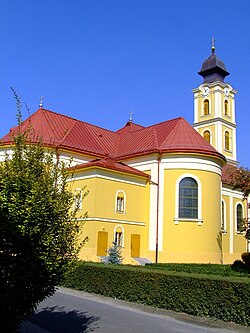Bácsalmás
Bácsalmás
Aljmaš, Almasch | |
|---|---|
 Church of the Holy Cross | |
|
UTC+2 (CEST) | |
| Postal code | 6430 |
| Area code | (+36) 79 |
| Website | www |
Bácsalmás (
, with a population of 7,694 people.History
In the
In the 17th century, there was a steady influx of
With the Turkish defeat at the
In the 19th century the town became a centre for wine and grain production which was exported mainly to Austria and Bohemia. It also became an important railroad junction. In effect it became a prosperous community. However, it retained its rural character the whole time with a strong artisan class which served the surrounding region.
In 1941, the town had a population of 13,000, two-thirds of whom were Germans (
In 1986, Bácsalmás became a town with a population of over 8,000. With the closure of some industries and the reforms in agriculture, the town is losing its population. Bácsalmás is struggling to replace the declining agricultural sector, but alternatives are hard to find. The farming cooperative privatized in the early 1990s and the local state farm accumulated large debts.
Twin towns – sister cities
 Backnang, Germany
Backnang, Germany Bajmok (Subotica), Serbia
Bajmok (Subotica), Serbia Bezdan (Sombor), Serbia
Bezdan (Sombor), Serbia Bizovac, Croatia
Bizovac, Croatia Borsec, Romania
Borsec, Romania Gizałki, Poland
Gizałki, Poland Veľký Meder, Slovakia
Veľký Meder, Slovakia
References
- ^ Votruba, Martin. "Maria Theresa's Urbarium". Slovak Studies Program. University of Pittsburgh. Archived from the original on 2015-02-23. Retrieved 2015-05-05.
- ^ "Bácsalmás (Menu) => Testvérvárosok". bacsalmas.hu (in Hungarian). Bácsalmás. Retrieved 2021-04-02.
- Dr. Mihály Mandics: A magyarországi bunyevác-horvátok története, Budapest, 1987.
- Horváth, Sövény, Harton: Bácsalmás, Szekszárd, 1999.
External links
- Official website in Hungarian


